Non-alcoholic fatty liver disease (NAFLD) is no longer a medical mystery whispered in hushed tones. It's bursting onto the scene, captivating headlines and sparking concern. But beneath the media buzz lies a complex reality, one demanding both awareness and informed action. So, let's shed light on this increasingly common condition, from its silent beginnings to the potential storms it can brew.
What is NAFLD?
Imagine your liver, the unsung hero of your body, burdened by an unwelcome guest: fat. This unwelcome visitor, in excess, is the hallmark of NAFLD. Unlike its alcohol-induced cousin, NAFLD arises from factors like obesity, diabetes, and metabolic syndrome. The result? A fatty liver struggling to function optimally.
Silent but Potent:
NAFLD often plays a quiet game. Many individuals remain symptom-free for years, unaware of the fatty infiltration silently happening within. Yet, this seemingly benign state can harbor serious consequences. Left unchecked, NAFLD can progress to non-alcoholic steatohepatitis (NASH), a more severe form marked by inflammation and liver damage. This, in turn, can pave the way for fibrosis (scarring) and ultimately, cirrhosis (end-stage liver disease).
The Alarming Rise:
NAFLD's prevalence is staggering. Estimates suggest it affects one in four adults globally, with rates even higher in countries grappling with obesity and metabolic disorders. This translates to hundreds of millions of individuals silently harboring the potential for future liver complications.
A Multifaceted Threat:
While NAFLD primarily targets the liver, its reach extends far beyond. It's associated with an increased risk of cardiovascular disease, diabetes, and even certain cancers. This intricate web of interconnected health issues underscores the urgency of addressing NAFLD as a multifaceted public health challenge.
Fighting Back: A Ray of Hope:
The good news is, NAFLD is not a life sentence. Lifestyle modifications remain the first line of defense. Weight loss, a healthy diet, regular exercise, and adequate sleep can significantly improve liver health and even reverse early-stage NAFLD. For individuals with more advanced stages, medications and even liver transplants may be necessary.
The Call to Action:
Here's where you come in. Awareness is the first step in tackling this growing threat. Understanding the risk factors, recognizing the potential dangers, and adopting healthy lifestyle practices can empower individuals to protect their liver health. Spread the word, champion healthy choices, and encourage regular checkups. By acting collectively, we can turn the tide on NAFLD and safeguard the silent, yet vital, hero within us all – our liver.
You need to know:
- Global NAFLD prevalence is estimated at 25%, with variations across regions.
- In the United States, NAFLD affects about 25% of adults and 10% of children.
- NAFLD is the leading cause of chronic liver disease in developed countries.
- Up to 20% of individuals with NAFLD progress to NASH within 5-10 years.
- Weight loss of just 5-10% can significantly improve liver health in NAFLD patients.
Remember, knowledge is power. By demystifying NAFLD and spreading awareness, we can empower individuals to protect their liver health and build a healthier tomorrow, one mindful choice at a time.







